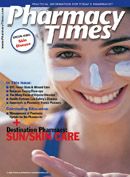Publication
Article
Pharmacy Times
Summer Notebook: Sun Protection, Skin Conditions
Dr. Coleman is an assistant professor of pharmacy practice and director of the pharmacoeconomics and outcomes studies group, and Dr. Girotto is an assistant clinical professor, at the University of Connecticut School of Pharmacy.

The warm and sunny days of summer are likely to bring questions from patients looking for help in preventing and treating conditions that crop up when spending more time outdoors and in the sun. Test your clinical skills with these summertime cases.
Infant Sun Protection
SD is a first-time mother of a 3-monthold boy. She has come to speak with the pharmacist because she cannot find a sunscreen with directions on how to apply it to her infant son. She asks the pharmacist which product would be best and how she should apply it. What should the pharmacist recommend for SD’s son?
First, the pharmacist should inform SD that the FDA has not approved any sunscreens for infants under the age of 6 months, because the potential exists for some chemicals in these products to be absorbed through their immature skin, and their organs may not be mature enough to eliminate these chemicals. Instead, the skin of young infants should be protected by keeping the infant in shaded areas (trees, umbrellas, etc) and through the use of protective clothing (hats, tight weaves). The pharmacist also should inform SD that, in circumstances where shaded areas are not available, the American Academy of Pediatrics suggests that it may be okay to apply sunscreen (in infants her son’s age) if it is only to small areas of the body (eg, face and/or back of hands).
Poison Ivy
JT comes into the pharmacy with his young son. The pharmacist notices that he has been in the first aid aisle for the past 10 to 15 minutes and approaches him to see if he can be of any assistance. JT states that he has been unable to find a product that will help stop the spread of his son’s poison ivy. The pharmacist then asks JT why he believes his son’s poison ivy is spreading. JT explains that his son had been exposed to poison ivy 2 weeks ago when he was at the beach. He has not been around it since, but he continues to have small areas of eruptions every few days. What can the pharmacist recommend for JT’s son?
The pharmacist can inform JT that poison ivy does not spread but may have a clinical course of a few weeks. A more feasible explanation for the new eruptions may be that his son is coming into contact with a toy, shoe, or other item that still has some of the plant’s oils on it. JT should make sure that all such items from the beach have been thoroughly cleaned.
Athlete’s Foot
TR is an 18-year-old man who works as a lifeguard at the local pool. He comes into your pharmacy after seeing a dermatologist because of an itchy, burning, inflamed fissure between the fourth and fifth toes of his left foot (diagnosed as athlete’s foot). After spending a few minutes in the aisle, TR brings 2 products up to the pharmacy counter and asks to speak with a pharmacist. He tells the pharmacist that his doctor told him to use an antifungal cream to treat the fungal infection, but he was not sure which product to use. TR has brought clotrimazole and miconazole to the counter. What should the pharmacist recommend?
Athlete’s foot (tinea pedis) is a common fungal infection caused by the organism Trichophyton rubrum. It is likely that TR contracted the infection from walking barefoot around the pool or locker room facilities at work. Thus, the first recommendation the pharmacist should make is for TR to avoid walking barefoot around the pool and locker room (purchase flip-flops), along with keeping his feet dry. As for choosing between the 2 products selected by TR (or other OTC choices), it is difficult to justify using one agent over another based upon safety or efficacy. Regardless of the product chosen, the pharmacist should remind TR that it should be continued for at least 1 week after resolution of the infection, typically for a total of 4 weeks. â–







